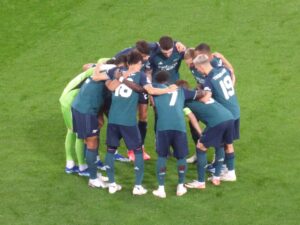Arteta’s Arsenal in 2023/24: better or worse?
One-third of Arsenal’s Premier League season will have been played after they take on Brentford at the Gtech Community Stadium this Saturday.
Unbeaten until a controversial 1-0 defeat at St James’s Park in early November, the Gunners sit in third place. They are one point behind league leaders Manchester City, and only three shy of the 30 they had tallied through 12 games last season.
Why, then, is there not that same feeling of unabridged elation and total consensus felt in the early stages of that campaign?

Arsenal huddle ahead of their 2-1 defeat at RC Lens in the Champions League / Supporterhéninois via Wikimedia Commons
Despite their impressive record domestically and in Europe, doubts persist about Mikel Arteta’s new-look Arsenal.
Kai Havertz has struggled to meet the demands of the ‘left eight’ after Granit Xhaka’s departure and the ‘right eight’ is now a matter of discussion too, with Martin Ødegaard struggling for fitness and form.
Even starboy Bukayo Saka is facing scrutiny.
Speaking to BBC Sounds, teammate Declan Rice noted criticism of the 22 year-old winger and defended his early season form, but called upon Saka to find “new ways to beat the opposition.”
Bukayo Saka limps off against Sevilla. Some feel his match load is affecting his performances.
It feels like Arsenal’s assured start to the season comes with an asterisk. But how much have the Gunners changed? Have they actually regressed?
The Sports Gazette dives into the data to find out.
More controlled, less creative
Despite its bitter end, the 22/23 season will long be remembered for the feelings it generated. Revelling in attacking play that was expansive and exciting, the Gooner faithful was united.
This season, control rather than creativity is the foundation of Arteta’s side. FBref data shows that Arsenal were less progressive with the ball in the twelve games played in this season’s Premier League than the 38 played last campaign.
The Gunners’ attacking play is less threatening too, with a decline in expected goals (xG) supporting the notion of a somewhat stilted attack.
However, the controlled approach is paying dividends on the defensive end.
Arsenal’s out-of-possession numbers are league-leading. Opponents have generated just 9.2 xG against the Gunners, with Manchester City (11.1) and Newcastle (13.2) coming in second and third.
According to xG, the defensive improvement has more than offset the attacking slump.
Rice, Rice baby
The acquisition of Declan Rice is important to understanding both these trends.
Despite costing an initial £100million, Rice’s price tag has scarcely been mentioned. Such has been the start he has made in North London, bringing physicality and nous to Arsenal’s out-of-possession play.
Rice has also scored vital goals against Manchester United and Chelsea
Rice may have solved problems defensively, but he has created some in Arsenal’s build-up play.
Unlike Thomas Partey, Arsenal’s ‘six’ of choice last season, Rice struggles playing with his back to goal. During build-up, the England international is seen operating outside the opposition block, frequently taking up deeper positions between the centre-backs or out on the left flank. Progression through the centre becomes more difficult as a result.
Rice’s limitations in build-up, as well as his pressing attributes, have led Arteta to opt for Jorginho’s veteran presence in defensive midfield during bigger games, with Rice taking up the ‘left eight.’
Jorginho earned starts against Tottenham, Manchester City, and former side Chelsea
Despite these efforts to compensate, Rice’s limitations in build-up pose a question that Arteta is yet to definitively answer.
White, Ødegaard, and Saka
Ben White, Ødegaard, and Saka combined to lethal effect on Arsenal’s right-hand side throughout the 2022/23 season.
This time out, the trio are struggling to summon that electric chemistry.
For Arsenal’s opener against Nottingham Forest, Thomas Partey started at right-back while White shifted into central defence. Though he has since returned to full-back, White’s license to foray forwards has been reined in.
Compared to last season, White has fewer touches in attacking areas.
His uses of the ball are more conservative too.
The ripple effects of this change may help us understand Saka’s mixed start to the campaign. Often facing two or three defenders, Saka needs White’s overlaps to occupy additional markers.
With the right-back less advanced, Saka cannot be as positive.
Ødegaard’s struggles may also have a systemic root. With limited progression through the middle, the Norwegian is getting fewer touches of the ball, especially in midfield.
System can explain some of his issues, but his inability to convert on an increasing share of touches in the final third points to a dip in form. Arsenal’s captain is registering 0.14 expected assists per 90 this Premier League season, having posted 0.23 in 2022/23.
The right-sided unit, the jewel in Arsenal’s attacking crown during the 2022/23 season, is now emblematic of an attacking decline.
Arsenal in 2023/24: better or worse?
The data shows that Arsenal are less expansive going forwards but have hit new heights as a defensive unit.
Their defensive prowess looks assured as long as Declan Rice, William Saliba, and Gabriel Magalhães remain fit. At the other end, a return to fitness and form for key players may prove the remedy for early season struggles.
Gabriel Jesus is just settling into the season now, having been injured in its early stages, while a player of Ødegaard’s quality is unlikely to struggle for long.
Optimism is not something Gooners will readily embrace after the heartbreak of last season, but there is reason to believe that Arteta’s new-look Arsenal can more than match the accomplishments of last season.